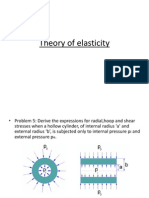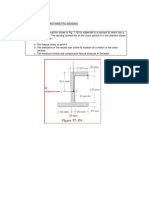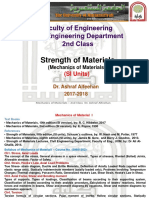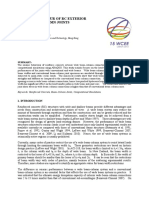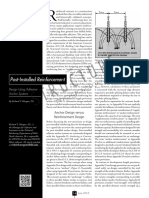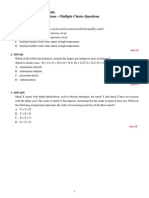Structural Dynamics (CIV-702) : L T P Credits 2 1 0 3
Uploaded by
kyleStructural Dynamics (CIV-702) : L T P Credits 2 1 0 3
Uploaded by
kyleNATIONAL INSTITUTE OF TECHNOLOGY SRINAGAR
HAZRATBAL, SRINAGAR, J&K - 190 006
Structural Dynamics (CIV-702)
L T P CREDITS
2 1 0 3
COURSE CONTENTS
S. No. Contents Contact Hours
Nature of dynamic loading: Harmonic, earthquake and blast
loading,
Single degree of freedom systems, free vibrations and forced
1 6
vibrations:
Harmonic force, Periodic force, Impulse, and General type of
loading.
REFERENCES
S. No. Name of Books/Authors/Publishers
Dynamics of Structures By Anil K. Chopra
1
2 Dynamics of Structures By Clough and Penzien
3 Structural Dynamics By Mario Paz
Structural Dynamics (CIV-702) 7th semester
NATIONAL INSTITUTE OF TECHNOLOGY SRINAGAR
HAZRATBAL, SRINAGAR, J&K - 190 006
Lecture 1st
1.1 Introduction
Structural dynamics is a type of structural analysis which covers the behavior of
structures subjected to dynamic loadings. Dynamic loadings are actions having high
acceleration. Dynamic loads include earthquake and blasts.
Dynamic analysis can be used to find dynamic displacements, time history and model
analysis.
A dynamic analysis is also related to the initial forces developed by the structure when its
excited by means of dynamics loads applied suddenly e.g. Wind blasts, explosions and
earthquake.
1.1.1 Degree of Freedom:-when a structure is loaded, specified points on it will undergo
unknown displacement. These displacements are referred to a degree of freedom for
structure.
In 3D each node on a frame or beam can have at most 3 linear and 3 rotational
displacements.
In 2D each node can have 2 linear displacements and one rotational displacement.
The process of idealization or selection of appropriate mathematical to model permits the
reduction in the No. of degree of freedom to discrete No. and in some cases to just single
degree of freedom.
Structural Dynamics (CIV-702) 7th semester
NATIONAL INSTITUTE OF TECHNOLOGY SRINAGAR
HAZRATBAL, SRINAGAR, J&K - 190 006
The structures shown above may be represented for dynamic analysis as one degree of
freedom system. ie Structures Modeled as system with a single displacement
coordinate.
Mathematical Model for one degree of freedom system.
m- Mass element m representing Mass and inertial characteristics of structure.
k- Spring element k representing the elastic restoring force and potential energy
capacity of structure.
C:- Damping C representing the frictional characteristics and energy loses of structure.
F(t) Excitation force representing external force acting on structure F (t) is written in
this way to represent it as function of time.
Every element in Mathematical Model represents single property.
1.2 Undamped system:
Lets start our study of structural dynamics with the analysis of fundamental and simple
system, ie one degree of freedom system in which we neglect frictional force and
vibration force from external forces under these conditions, the system is in motion
governed only by the influence of the so called initial conditions ie given displacement
and velocity at time t=0. This undamped one degree of freedom system is often referred
to as simple undamped oscillator.
Representation
Structural Dynamics (CIV-702) 7th semester
NATIONAL INSTITUTE OF TECHNOLOGY SRINAGAR
HAZRATBAL, SRINAGAR, J&K - 190 006
In the Models shown above the Mass m is restrained by spring k and limited to rectilinear
Motion along one coordinate axis. The mechanical characteristics of a spring is described
by a relation between the magnitude of force F (s) applied to its free end the resulting end
displacement y as shown graphically in Fig. below for three different springs.
a. (Hard Spring)
b. (Linear Spring)
c. (soft Spring)
Hard Spring:- Force required to produce a given displacement becomes increasing greater
as spring deformed. Soft spring is vice versa from linear spring.
From linear spring
Fs y
Fs = k y where k = Spring constant
Base for our dynamics
works/analysis.
Structural Dynamics (CIV-702) 7th semester
NATIONAL INSTITUTE OF TECHNOLOGY SRINAGAR
HAZRATBAL, SRINAGAR, J&K - 190 006
Zone E represents displacements produced in structure by the action of external force or
disturbances of small Magnitude, thus rendering linear approximately close to structural
behavior.
1.3.1 Spring in series or parallel:-
1.3.2 Springs in series:-
Free Body Diagram:-
Single degree of freedom system (a)
External forces only (b)
External and Internal forces (c)
The F BD is a sketch of the body isolated from all other bodies, in which all the forces
external to the body are shown. As shown in Fig. (b) F BD of Mass m of the oscillator
displaced in positive direction wrt to coordinate y and acted upon the spring force F s=ky
Structural Dynamics (CIV-702) 7th semester
NATIONAL INSTITUTE OF TECHNOLOGY SRINAGAR
HAZRATBAL, SRINAGAR, J&K - 190 006
(assuming linear). The weight of body mg and normal reaction N of the supporting
surface are also shown for completeness. Though these forces act in virtual direction do
not enter into the equation of Motion written for y direction. The application of Newtons
Law of Motion gives.
F = Ma y = displacement
-ky = m = velocity
= acceleration
Where spring force acts in negative direction/opposite so it has negative sign.
1.4 D Alemberts Principle:-
An alternative approach to obtain eq -k y = m is the make use of D Alemberts
Principle, which states that a system may be set in a state of dynamic equilibrium by
adding to the external forces a fictitious force which is commonly known as inertial
force.
The application of D Alemberts Principle allows us to use eqn of eqmb in obtaining eq
of Motion.
Fy = m + k y = 0
Or ky = m .
Solution of the differential Eq of Motion
(m + k y =0) ----- (1)
Lets adopt a systematic approach and proceed to first classify the differential Eq. Since
dependent variable and appear in the first degree so this eq is classified as linear and
of second order.
The fact that the coefficients of and are k and m respectively are constants and r h s of
eq is zero.
Further classify the eq as homogeneous with constant coefficients.
For this simple second order differential eq we may proceed directly by assuming a trial
solution given by
y = A Cos t ------ (2)
Structural Dynamics (CIV-702) 7th semester
NATIONAL INSTITUTE OF TECHNOLOGY SRINAGAR
HAZRATBAL, SRINAGAR, J&K - 190 006
y = B Sin t ------- (3)
Where A and B are constants depending on imitation of Motion.
is quantity denoting physical characteristics of system
Subt eq 2 in eq 1
(m 2 + k) A cos t = 0 ------- (4)
This eqn is to be satisfied at any time the factor in parentheses must be equal to zero or
2 = k/m ------- (5)
eq 3 is also solution of differential eq 1 with also satisfying (5)
= k/m (6)
is known as natural frequency of system
Eqn 2 and 3 are solution of 1 since its a differential eq and linear supper position of these
two solutions is also a solution.
y = A cos t + B sin t ------- (7)
= -A sin t + B cos t ------ (8)
Now we will find values of integration constants A and B using initial conditions.
When t = 0, y = y0 and y = v0
Subt in eq 7 and 8
y0 = A ------ (9)
v0 = B ------ (10)
Finally y = y0 cos t + v0/ sin t ------ (11)
Thus the Motion of simple undamped oscillator Modeling structures with a single degree
of freedom is given by y or eq 11
1.5 Amplitude of Motion:
Lets now examine in more detail eq 11. The simple trigonometric transformation may
show us that we rewrite eq in equalent forms namely:
Structural Dynamics (CIV-702) 7th semester
NATIONAL INSTITUTE OF TECHNOLOGY SRINAGAR
HAZRATBAL, SRINAGAR, J&K - 190 006
y = (sin (t + ) ------ (12)
y = (cos (t ) ------ (13)
C = y02 + (v0/)2 ----- (14)
tan = y0/ v0/ ------- (15)
and tan = v0//y ------ (16)
or
Multiple and divide eq 11 by factor C ie eq 14 to define or by eq 15 and 16
y = C [y0/C cos t + v0//C sin t]
sin = y0/C and cos = v0/
y = C [sin cos t + cos sin t] ------ (17)
The value of C in eq C = y02 + (v0/)2 is called amplitude of Motion and angle or as
phase angle.
Structural Dynamics (CIV-702) 7th semester
NATIONAL INSTITUTE OF TECHNOLOGY SRINAGAR
HAZRATBAL, SRINAGAR, J&K - 190 006
Undamped free vibration response.
Structural Dynamics (CIV-702) 7th semester
NATIONAL INSTITUTE OF TECHNOLOGY SRINAGAR
HAZRATBAL, SRINAGAR, J&K - 190 006
Lecture 2nd
2.1 Viscous Damping:-
In considering damping forces in the dynamic analysis of structures its usually assumed
that these forces are proportional to the Magnitude of the velocity and opposite to the
direction of Motion. This type of damping is known as viscous damping. Its the type of
damping force that could be developed in a body restricted in its Motion by surrounding
fluid.
Equation of Motion of a body with dampers.
Lets assume a modelled structural system as a simple oscillator with viscous damping.
Viscous Damped Oscillator
Where m and k are mass and spring constants of the oscillator. C is the Viscous damping
coefficient.
Draw F B D (as show above) and apply Newtons Law to obtain differential equation of
Motion.
Fy = m + C + Ky = 0 --------- (1)
In this case y = A sin t and y = B cos t will not satisfy (as in case of undamped).
However functions y = Ceptwill satisfy subt y in eq --- (1)
m C p2 ept + C Cpept + K C ept = 0
Structural Dynamics (CIV-702) 7th semester
NATIONAL INSTITUTE OF TECHNOLOGY SRINAGAR
HAZRATBAL, SRINAGAR, J&K - 190 006
=> m p2 + C P + K = 0 ------ (2)
p1 and p2 are roots
= - C/2m (C/2m)2 k/m ------ (3)
Thus the general solution of eq (1) is given by super position of the two possible
solutions.
y (t) = C1 ep1t + C2 ep2t ------- (4)
Where C1 and C2 are constants of interrelation and elastic for initial condition.
The final form of eq (4) depends on the sign of expression under radical ----- (3).
Now three cases arise.
(C/2m)2 k/m can be Zero
can be Positive
can be Negative
If (C/2m)2 k/m = Zero, Damping in this case is called critical Damping.
2.2 Critical Damping System
As explained above
(C/2m)2 k/m = 0
(Ccr/2m)2 k/m = 0
Ccr = 2km ------ (5)
Where Ccr designates critical damping value.
Since Natural frequency of undamped system is given by = k/m subt in eq ---- (5)
Ccr = 2m = 2k/
In a critically damped system the roots of the characteristics eq are equal and eq ---(3)
p1 = p2 = -Ccr/2m
Since the two roots are equal, the general solution given by eq (4) would provide only
one independent constant of Integration hence one independent solution.
Structural Dynamics (CIV-702) 7th semester
NATIONAL INSTITUTE OF TECHNOLOGY SRINAGAR
HAZRATBAL, SRINAGAR, J&K - 190 006
y1 (t) = C1 e (Ccr/2m)t ------ (6)
Another independent solution may be found by using the subt.
y2 (t) = C2 e (Ccr/2m)t ------ (7)
Thus general solution of critically damped system is the given by super position of (6)
and (7)
y (t) = (C1 + C2 t) e (Ccr/2m)t ------ (8)
2.3 Over Damped System
In an over damped system, the damping coefficient is greater than the value for critical
damping.
C > Ccr
(C/2m)2 k/m is positive and roots are roll and distinct given by
y (t) = C1 ep1t + C2 ep2t
In case of critical damping and over damping the resulting Motion is not oscillating, the
Mag of the oscillation decays exponentially with time to zero.
2.4 Under Damped System
Where the value of damping coefficient is less than critical value (C < Ccr)
ie (C/2m)2 k/m is negative < 0
Structural Dynamics (CIV-702) 7th semester
NATIONAL INSTITUTE OF TECHNOLOGY SRINAGAR
HAZRATBAL, SRINAGAR, J&K - 190 006
The roots of are complex conjugate
p1
p2 = - C/2m i k/m - (C/2m) ------ (9)
2
Where i = -1 imaginary unit.
For this case make use of Eulers equation.
eix = cos x + i sin x
e-ix = cos x + i sin x
subt eq (9) is roots into
y (t) = C1 ep1t + C2 ep2t
and use eix and e-ix
=> y (t) = e (Ccr/2m)t (A cos Dt +B sin Dt) ------ (10)
Where A and B are constants of Integration and D, the damped frequency of system
given by
=> D = k/m - (C/2m)2
D = 1-2
We know 2 = k/m
Undamped Natural Frequency
or = k/m
= C/Ccr is damping ratio
Where initial conditions of displacement and velocity are used is t = 0 y = y0 and = vo.
A and B can be evaluated eq (10)
y (t) =e-t [y0 cos Dt +( vo + y0 /D ) sin Dt] ------ (11)
Alternatively
y (t) = Ce-t (cos Dt )
C = y02 + (vo + y0 ) 2/D2
tan = (vo + y0 ) 2/D y0
Structural Dynamics (CIV-702) 7th semester
NATIONAL INSTITUTE OF TECHNOLOGY SRINAGAR
HAZRATBAL, SRINAGAR, J&K - 190 006
Graphically under damped systems vibration response is represented by
TD = 2/D = 2/1- 2
It may be seen Motion is oscillatory but not periodic.
2.5 Logarithmic decrement
A practical method for deterring experimentally, the damping coefficient of a system is to
initiate free vibration obtain a record of oscillatory Motion and measure rate of decay of
amplitude of Motion.
Structural Dynamics (CIV-702) 7th semester
NATIONAL INSTITUTE OF TECHNOLOGY SRINAGAR
HAZRATBAL, SRINAGAR, J&K - 190 006
The decay may be conveniently expressed by log decrement ie = Ln y1/y2
We know
y (t) = Ce-t cos (Dt )
When cos (Dt ) =1 ie Tangent pt
y (t) = Ce-t
Now
y1 (t) = Ce-t1
y2 (t) = Ce-t1 [t1+TD]
=Ln y1/yn = TD
TD = 2/D
= 2 /1-2
Structural Dynamics (CIV-702) 7th semester
NATIONAL INSTITUTE OF TECHNOLOGY SRINAGAR
HAZRATBAL, SRINAGAR, J&K - 190 006
Summary
Till now we have learnt about
1. F B D
2. D Alemberts principle
3. Different eventual equation of undamped simple oscillator ie [SDOF] in free
Motion is
m + k = 0
y = A cos t + B sin t
4. Equation of Motion can be written in All forms.
y = C sin [t + ]
y = C sin [t - ]
Where C y02 + (vo/) 2
5. Differential eq of Motion for damped single degree of freedom system.
m + C + ky = 0
6. Damping ratio Ccr
a=1
b<1
c>1
y (t) = Ce-t [y0 cos Dt + vo + y0 /D sin Dt]
7. Logarithmic decrement.
Structural Dynamics (CIV-702) 7th semester
NATIONAL INSTITUTE OF TECHNOLOGY SRINAGAR
HAZRATBAL, SRINAGAR, J&K - 190 006
Lecture 3rd
3.1 Undamped harmonic Excitations
The impressed force F(t) acting on simple oscillator show in fig is assumed to be
harmonic and equal to F0 sin t
Or F(t) = F0 sint
Where F0 is the peak amplitude
= Frequency of force in each/sec
From FBD ( fig b)
m + Ky = F0 sin t ------- (1)
y (t) = yc(t) + yp (t) ------ (2)
Where yc(t) is the complementary solution satisfying homogeneous eq. (1) with LHS
equal to zero
and yp (t) is particular solution based on solution satisfying the non homogeneous
differential eq. (1)
yc(t) = A cos t + B sin t -----(3) = k/m
The nature of forcing function in eq. (1) suggests that particular solution can be taken as
yp(t) = Y sin t ----- (4)
Where Y is peak value of particular solution.
Subt eq. (4) in eq (1)
Structural Dynamics (CIV-702) 7th semester
NATIONAL INSTITUTE OF TECHNOLOGY SRINAGAR
HAZRATBAL, SRINAGAR, J&K - 190 006
- m 2 y + ky = F0
y = F0/k-m 2 = F0/k/1-r2 ------ (5)
r = / ------ (6)
frequency ratio r is the ratio of applied forced frequency to the natural frequency of
vibration of system
Adding eq (3) and (5)
y(t) = (A cos t + B sin t) + {(F0/k)/(1-r2 )}sin t ------ (6)
When t = 0 y0 = 0 ; 0 = 0
A = 0 ; B = rF0/k/1-r2
Subt in eq (6)
y(t) = F0/k/1-r2 (sin t r sin t) ----- (7)
From eq (8) we can see the response is given by the superposition of two harmonic terms
of different frequencies. The resulting Motion is not harmonic, however in practical case
damping forces will always be present in system and will cause free frequency ie r sin
t to vanish.
Therefore r sin t is called transient response.
While forcing frequency; (t) ={ (F0/k)/(1-r2 )}sin t ----- (8) is called steady response.
If there is no damping transient will not vanish.
When forcing frequency is equal to Natural frequency (r = 1) the amplitude of Motion
becomes large. A system actual upon by an external excitation of frequency coinciding
with natural frequency is said to be at resonance.
3.2 Damped harmonic Excitation
Considers the case of one degree of freedom system shown in fig. Vibrating under the
influence of viscous damping.
Structural Dynamics (CIV-702) 7th semester
NATIONAL INSTITUTE OF TECHNOLOGY SRINAGAR
HAZRATBAL, SRINAGAR, J&K - 190 006
The differential eq of motion is given by
m + C + Ky = F0 sin t ------- (9)
The complete solution of this eq is given by
y (t) = yc (t) + yp (t)
ie complementary solution + particular solution
Complementary solution for under damped case (C< Ccr) is given as
yc (t) = e-t (A cos Dt + B sin Dt) ------- (10)
The particular solution may be found by substituting yp in this case assumed to be of the
form
yp(t) = C1 sint + C2 cost------- (10)
subst into eq (9) and Equating coefficients of sine and cosine functions.
From Eulers relation
eit = cost + isint
We can write eq 9 as
m + C + Ky = F0 eit ------ (12)
ie m + C + Ky = F0 [cos t +i sin t]
Structural Dynamics (CIV-702) 7th semester
NATIONAL INSTITUTE OF TECHNOLOGY SRINAGAR
HAZRATBAL, SRINAGAR, J&K - 190 006
only imaginary component F0eit ie force component of F0sint is acting and
consequently, the response will them consist only of imaginary part of total solution of eq
(12)
In other words total solution has real and imaginary component and disregard real
component then particular solution of eq (12) will be of form
yp = C iet ------ (13)
subt eq (13) in eq (12)
-m 2 C + iC C + kC = F0
C = F0/k-m 2 + iC
yp = F0 eit/ k-m 2 + iC ------ (14)
By using polar coordinate form of complete denominate in eq (14)
yp = F0 eit /(k-m 2)2 + (C)2 ei
Or yp = F0 ei(t-)/(k-m 2)2 + (C)2 ------ (15)
tan = C/k-m2 ------ (16)
The response to the force F0sint ie imaginary component of F0eit imaginary component
of eq (15)
yp = F0 sin (t-)/(k-m 2)2 + (C)2 ------ (17)
yp = y sin (t -) ------ (18)
y = F0/(k-m 2)2 + (C)2 is the amplitude of steady state Motion
Eq (17) and (18) may be written as
yp = yst sin (t -)(1-r2)2 + (2r)2 ------ (19)
tan = 2r/1-r2 ------ (20)
Where yst = F0/k, static deflection of spring acted upon by force F0
Structural Dynamics (CIV-702) 7th semester
NATIONAL INSTITUTE OF TECHNOLOGY SRINAGAR
HAZRATBAL, SRINAGAR, J&K - 190 006
= C/Ccr, damping ratio
r = /, frequency ratio
Total response of Damped Harmonic Excitation is given by
y(t) = e-t (A cos Dt + B sin Dt) + yst sin (t )/(1-r2)2 + (2r)2 ------ (21)
Dynamic Magnification factor
D = y/yst = 1/(1-r2)2 + (2r)2 ------ (22)
D varies with frequency ratio r and damping ratio .
3.3.1Response to support Motion
There are many actual cases where the foundation or support of a structure is subjected to
time varying motion structures subjected to ground motion by earthquakes or other
excitations such as explosion or dynamic action of machinery are examples in which
support motions may have to be considered in the analysis of dynamic response.
Lets consider a simple oscillator as shown in fig.
ys(t) = y0 sint ------ (23)
Where y0 is maximum amplitude
Structural Dynamics (CIV-702) 7th semester
NATIONAL INSTITUTE OF TECHNOLOGY SRINAGAR
HAZRATBAL, SRINAGAR, J&K - 190 006
frequency of the support
From F. B.D (fig. b)
Differential eq of Motion in horizontal direction
m + C(-s) + K(y-ys)= 0 ------ (24)
subt eq (23) into eq (24)
m + C + Ky + Ky0 sin t + C y0 cos t ------- (25)
m + C + Ky =F0 sin (t + ) ------ (26)
Where F0 = y0 k + (C)2
F0 = y0 k1 + (2r)2 ------ (27)
tan = C/k = 2r ------ (28)
Eq (26) is the differential equation for oscillator excitation by harmonic force F0
sin(t + ) and is of same force as eq of damped harmonic Excitation.
y (t) = F0/k sin (t + - )/(1-r2)2 + (2r)2 ------ (29)
subt F0 from eq (27)
y (t)/y0 = {1 + (2r)2/(1-r2)2 + (2r)2 }sin (t + - ) ------ (30)
Eq (30) is the expression for the relative transmission of the support motion to the
oscillator. This is an important problem in vibration isolation in which equipment must be
protected from harmful vibration of supporting structure. The degree of relative isolation
is known as transmissibility.
3.3.2 Transmissibility is defined as ratio of Motion Y of oscillator to amplitude y0 the
Motion of support
From eq 30, transmissibility Tr = y/y0 = 1 + (2r)2/(1-r2)2 + (2r)2------- (31)
Damping tends to reduce the effectiveness of vibration isolation for frequencies ie
frequency ratio greater than 2 ie r > 2
Structural Dynamics (CIV-702) 7th semester
NATIONAL INSTITUTE OF TECHNOLOGY SRINAGAR
HAZRATBAL, SRINAGAR, J&K - 190 006
3.3.3 Force Transmitted to the Foundation
Consider a damped oscillator with a harmonic Force F(t) = F0 sint acting on its Mass as
shown in last fig.
The differential eq of Motion is
m + C + Ky = F0 sin t
with steady state solution
y = Y sin (t-)
Where Y = F0/k/(1-r2)2 + (2r)2
= Y cos (t-)
and tan = 2r/1-r2
The force transmitted to the support through spring ky and through damping element is
C. The total force transmitted FT
FT = ky + C
FT = Y [k sin (t-) + C cos(t-)]
FT = Y k2+C2 2 sin (t-+)
FT = Y k2+C2 2 sin (t+) ---- Total phase angle
in which tan = C/k = 2r and = -
From value of Y and FT, the force AT transmitted to the foundation is
AT = F0 1 + (2r)2/(1-r2)2 + (2r)2
Transmissibility; Tr = AT/F0 = 1 + (2r)2/(1-r2)2 + (2r)2
Transmissibility of Motion from foundation to the structure and transmissibility of force
from structure to foundation are given by exactly same function.
We know = (-)
tan = tan -tan /1 + tan tan
tan = 2r/1-r2 ; tan = 2rtan = 2r/1-r2 + 42r2
Structural Dynamics (CIV-702) 7th semester
NATIONAL INSTITUTE OF TECHNOLOGY SRINAGAR
HAZRATBAL, SRINAGAR, J&K - 190 006
Lecture 4
4.1Introduction:-
In preceding lectures we studied response of SDOF system with harmonic loading.
Though this type of loading is important, real structures are often subjected to loads
which are not harmonic.
In present lecture we will study the response of SDOF system subjected to general type
of force i.e. dynamic loading.
The response can be obtained in terms of an integral which for many simple load
functions can be can be evaluated analytically.
4.2Impulsive Loading and Duhamels Integral:-
An impulse loading is a load which is applied during a short duration of time. The
corresponding impulse of this load is defined as the product of force and the time of its
duration.
General load history as impulsive loading
Example ; the impulse of the force f() depicted in figure above at time during interval
d is represented by the shaded area and is equal to F()d.
Structural Dynamics (CIV-702) 7th semester
NATIONAL INSTITUTE OF TECHNOLOGY SRINAGAR
HAZRATBAL, SRINAGAR, J&K - 190 006
The impulse acting on a body of mass m, produces a change in velocity which can be
determined from Newtons Law of Motion i.e.
F()=mdv/d
Or dv=F()d/m-----------------------1
Where F()d is the impulse and dv is incremental velocity. The incremental velocity
may be considered to be initial velocity of mass at time .
Now lets consider this impulse F()d acting on the structure represented by undamped
oscillator. At time the oscillator will experience a change of velocity give by eq 1 i.e.
dv=F()d/m
This change in velocity i.e. dv is introduced in expression of displacement of SDOF
system i.e.
y = y0 cos t + v0/ sin t ------------------------2
At time oscillator will experience change in velocity given by dv.
The change in velocity ,dv is introduced in eq 2 as v0 i.e. initiall velocity together with
initiall displacement y0 =0 at time producing a displacement at latter time t given by
dy(t)= (F()d/m)sin (t- )-------------3
the loading history may then be regarded as series of short impulses at successive
incremental times d each producing its own different response at time t of form given by
eq 3.
Therefore, we conclude that total displacement at time t due to continuous action of the
force F() is given by
y(t)= 1/m () ( ) -------------------4
y(t) is Duhamel Integral
Eq 3 represents total displacement produced by existing force F() acting on undamped
oscillator ; it includes both steady state and transient components of motion.
To include effect of initiall displacement and initial velocity i.e. t=0 ; y= y0 ; v= v0
Structural Dynamics (CIV-702) 7th semester
NATIONAL INSTITUTE OF TECHNOLOGY SRINAGAR
HAZRATBAL, SRINAGAR, J&K - 190 006
Add eq 2 & 4
y(t)= y0 cos t + v0/ sin t +1/m 0 F()sin (t )d------------------------ 5
Thus the total displacement of an undamped SDOF system with arbitrary load is given by
eq 5 i.e.
y(t)= y0 cos t + v0/ sin t +1/m () ( )
4.3Application:-
Application of total displacement of an undamped SDOF system with arbitrary load is
given by some simple forcing function for which its is possible to obtain the explicit
integration.
A) Constant force :-
Undamped Oscillator acted upon by a constant force
Consider the case of a constant force of magnitude F0 applied suddenly to the undamped
oscillator at time =0 as shown in fig above . For both initial displacement and initial
velocity equal to zero, the application of eq 5 to this case gives
y(t)= 1/m 0 Fosin (t )d
y(t)= F0/m [cos (t- )]0
y(t)= F0/k(1-cos t)
y(t)=Yst (1-cos t)-----------------------------------------6
it will be observed that this solution is very similar to the solution for free vibrations of
the undamped oscillator . The major difference is that the coordinate axis t has shifts by
an amount equall to Yst = F0/k
Structural Dynamics (CIV-702) 7th semester
NATIONAL INSTITUTE OF TECHNOLOGY SRINAGAR
HAZRATBAL, SRINAGAR, J&K - 190 006
Response of an undamped single degree of freedom system to a suddenly applied constant force.
B) Rectangular load:-
Maximum dynamic load factor for the undamped oscillator acted upon by a rectangular force
Lets consider a second case , that of a constant force F0 suddenly applied but only during
a limited time duration td as shown in fig above.
Upto the time td , y(t)= Yst (1-cos t)
Upto the time td , y(t) = F0/k(1-cos t)
Structural Dynamics (CIV-702) 7th semester
NATIONAL INSTITUTE OF TECHNOLOGY SRINAGAR
HAZRATBAL, SRINAGAR, J&K - 190 006
Displacement , yd = F0/k(1-cos td)
Velocity vd= F0/k ( sin td)
For response after td
Apply; y= y0 cos t + v0/ sin t
Taking as the initial conditions the displacement and velocity at td . After replacing t by
t-td and y0 and v0 by yd and vd
y(t) = F0/k(1-cos td)cos (t-td) + F0/k sin td sin (t-td)
or y(t) = F0/k[cos (t-td)-cost]----------------7
Dynamic Load Factor ,[DLF]= y(t)/yst
From eq 6
DLF = 1-cost t td
From eq 7
DLF = cos (t-td) cos t td
If =2/T i.e. dimensionless parameter.
From eq 6
DLF= 1-cos2t/T t td
From eq 7
DLF= cos 2 (t/T-td/T) cos2 t/T t td
The ratio of dimensionless parameter serves to emphasize the fact that the ratio of
duration of the time the constant force is applied to the natural period rather than the
actual value of either quantity is the important parameter. From response spectral chart
above max dynamic load factor for loads of duration td/T 0.5 is the same as if the load
duration had been infinite.
Structural Dynamics (CIV-702) 7th semester
NATIONAL INSTITUTE OF TECHNOLOGY SRINAGAR
HAZRATBAL, SRINAGAR, J&K - 190 006
C) Triangular Load:-
Maximum dynamic load factor for the undamped oscillator acted upon by a rectangular force
We will now consider a system represented by the undamped oscillator, initially at rest
and subjected to a force F(t) which has initial value F0 and which decreases linearly to
zero at time td as shown in fig below . The response may be computed by eq 5 i.e.
y(t)= y0 cos t + v0/ sin t +1/m 0 F()sin (t )d ;
in two intervals td and t td
For 1st interval i.e. td force , F()= F0[1-/td]
Since system is at rest, therefore, initial conditions are
y0 =0 v0=0
Substitute in eq 5 and integrate
Structural Dynamics (CIV-702) 7th semester
NATIONAL INSTITUTE OF TECHNOLOGY SRINAGAR
HAZRATBAL, SRINAGAR, J&K - 190 006
y = F0 /k (1-cos t)+F0/ktd[(sin t/ )-t]-------------------------8
or in terms of DLF and dimensionless parameters
DLF=y/Yst=1-cos( 2t/T)+[(sin( 2t/T)/ 2td/T)-t/td]----------------9
This defines response before time td
For second interval i.e. ttd
We will obtain from eq 9 the displacement and velocity at time td as
yd=F0/k[ (sin td/ td )- cos td] & vd= F0/k[sin td+(cos td/td)-1/td]
these values may be considered as the initial conditions at time t=td for this second
interval.
Replace in eq y= y0 cos t + v0/ sin t , t by (t-td) and y0 and v0 respectively bt yd and vd
While F()=0 we obtain response as
y= F0/k td{sin t-sin (t-td)}- F0/k cos t
since F0/k = yst ; DLF = y/yst
Therefore, DLF= 1/td{sin t-sin (t-td)}- cos t --------------10
Substitute =2/T
DLF= 1/2 td /T{sin 2 t/T-sin 2 (t/T-td/T)}- cos 2 t/T
The response spectral chart above shows the maximum value of DLF approach 2 as td/T
becomes large; i.e., effect of the decay of the force is negligible for the time required for
the system to reach the maximum peak.
------------------------------------------------------------------------------------------------------------
Note:- Module to be continued
For Queries
Contact : Peerzada Mudasir Dewani
mudasirdewani@gmail.com
9419011168
Structural Dynamics (CIV-702) 7th semester
NATIONAL INSTITUTE OF TECHNOLOGY SRINAGAR
HAZRATBAL, SRINAGAR, J&K - 190 006
Structural Dynamics (CIV-702) 7th semester
You might also like
- 6 - Engesser's Theorem and Truss Deflections by Virtual Work PrinciplesNo ratings yet6 - Engesser's Theorem and Truss Deflections by Virtual Work Principles14 pages
- A Gestalt Therapy Approach To Shame and Self100% (4)A Gestalt Therapy Approach To Shame and Self20 pages
- FEM Analysis On Stiffened Plates Using ANSYS: Bachelor of Technology in Mechanical Engineering byNo ratings yetFEM Analysis On Stiffened Plates Using ANSYS: Bachelor of Technology in Mechanical Engineering by37 pages
- Chapter 7: Introduction To Column Analogy MethodNo ratings yetChapter 7: Introduction To Column Analogy Method42 pages
- ANALYSIS OF FLANGED SECTION (EC2) - Updated 020712No ratings yetANALYSIS OF FLANGED SECTION (EC2) - Updated 02071223 pages
- CIV308 - Introduction of Dynamic StructureNo ratings yetCIV308 - Introduction of Dynamic Structure27 pages
- Generalized Single-Degree-of-Freedom Systems: Chopra: Prentice-Hall PAGES JUL. 19, 2000 14:21 ICC Oregon (503) 221-9911No ratings yetGeneralized Single-Degree-of-Freedom Systems: Chopra: Prentice-Hall PAGES JUL. 19, 2000 14:21 ICC Oregon (503) 221-991138 pages
- Earthquake Engineering - CE 232 Quiz Time Allowed: 1 HourNo ratings yetEarthquake Engineering - CE 232 Quiz Time Allowed: 1 Hour9 pages
- Effect of Lateral Load Patterns in Pushover Analysis: November 2009No ratings yetEffect of Lateral Load Patterns in Pushover Analysis: November 20096 pages
- Plastic Limit State of Frame StructuresNo ratings yetPlastic Limit State of Frame Structures62 pages
- Unit - 5 Isoparametric Element Formulation: 1.what Is The Purpose of Isoparametric ElementsNo ratings yetUnit - 5 Isoparametric Element Formulation: 1.what Is The Purpose of Isoparametric Elements3 pages
- Slope and Deflection Method For Continuous BeamsNo ratings yetSlope and Deflection Method For Continuous Beams18 pages
- Lec7 Flexibility Method and Stiffness MethodNo ratings yetLec7 Flexibility Method and Stiffness Method34 pages
- Thomas Algorithm For Tridiagonal Matrix Using PythonNo ratings yetThomas Algorithm For Tridiagonal Matrix Using Python2 pages
- 14.beam Analysis Using The Stiffness MethodNo ratings yet14.beam Analysis Using The Stiffness Method23 pages
- Sri Vidya College of Engineering & Technology Virudhunagar: Department: Semester: Vi SUBJECT CODE / Name: CE 6602No ratings yetSri Vidya College of Engineering & Technology Virudhunagar: Department: Semester: Vi SUBJECT CODE / Name: CE 660234 pages
- Concrete Lectures Slab.2 Direct Design Method - PPT ExamplesNo ratings yetConcrete Lectures Slab.2 Direct Design Method - PPT Examples58 pages
- m4l24 Lesson 24 The Direct Stiffness Method: Truss Analysis100% (1)m4l24 Lesson 24 The Direct Stiffness Method: Truss Analysis23 pages
- Bme 101 201 Fundamental of Mechanical EnggNo ratings yetBme 101 201 Fundamental of Mechanical Engg25 pages
- bme-101-201-fundamental-of-mechanical-enggNo ratings yetbme-101-201-fundamental-of-mechanical-engg25 pages
- Chapter 1 - Principles of statics-2CE-4No ratings yetChapter 1 - Principles of statics-2CE-413 pages
- Ground Stabilization: Injetting Cement Grouting Using Pump and Injetion PipeNo ratings yetGround Stabilization: Injetting Cement Grouting Using Pump and Injetion Pipe3 pages
- Other Considerations When Doing Basement WorksNo ratings yetOther Considerations When Doing Basement Works5 pages
- Commonality Found in Recent Basement Projects (Cont.)No ratings yetCommonality Found in Recent Basement Projects (Cont.)5 pages
- Ground Stabilization: Injetting Cement Grouting Using Pump and Injetion PipeNo ratings yetGround Stabilization: Injetting Cement Grouting Using Pump and Injetion Pipe2 pages
- Basement Project in Very Congested Urban Environment - The Redevelopment of Kwong On Bank in Queen's Road Central, Central District, Hong KongNo ratings yetBasement Project in Very Congested Urban Environment - The Redevelopment of Kwong On Bank in Queen's Road Central, Central District, Hong Kong5 pages
- Other Considerations When Doing Basement WorksNo ratings yetOther Considerations When Doing Basement Works5 pages
- Other Considerations When Doing Basement WorksNo ratings yetOther Considerations When Doing Basement Works5 pages
- Complicated Surrounding Environment As Seen in The TST East Station - Underpinning To A Section of Pedestrian SubwayNo ratings yetComplicated Surrounding Environment As Seen in The TST East Station - Underpinning To A Section of Pedestrian Subway5 pages
- The Construction of Deep and Complex Basements and Underground Structures Within Extremely Difficult Urban EnvironmentNo ratings yetThe Construction of Deep and Complex Basements and Underground Structures Within Extremely Difficult Urban Environment5 pages
- Post-Installed Rebar Guide Technical Information ASSET DOC LOC 7210535No ratings yetPost-Installed Rebar Guide Technical Information ASSET DOC LOC 721053569 pages
- Aspiring Structural Engineers: University Guide ForNo ratings yetAspiring Structural Engineers: University Guide For10 pages
- Seismic Behaviour of RC Exterior Wide Beam-Column Joints: S.H. Luk and J.S. KuangNo ratings yetSeismic Behaviour of RC Exterior Wide Beam-Column Joints: S.H. Luk and J.S. Kuang10 pages
- Seismic Behaviour of RC Exterior Wide Beam-Column Joints: S.H. Luk and J.S. KuangNo ratings yetSeismic Behaviour of RC Exterior Wide Beam-Column Joints: S.H. Luk and J.S. Kuang10 pages
- MOCK PAPER 1 Marking Scheme November Exam AASLNo ratings yetMOCK PAPER 1 Marking Scheme November Exam AASL32 pages
- Physical Education and Health 12: 3 Quarter Week 3No ratings yetPhysical Education and Health 12: 3 Quarter Week 36 pages
- Human Resource Management Assignment Case Study - Job Analysis at Go-ForwardNo ratings yetHuman Resource Management Assignment Case Study - Job Analysis at Go-Forward11 pages
- Pattern Recognition Letters: Xiaohua Xia, Suping Fang, Yan XiaoNo ratings yetPattern Recognition Letters: Xiaohua Xia, Suping Fang, Yan Xiao6 pages
- Weibull Analysis Guide & Case Study - Pardus ConsultingNo ratings yetWeibull Analysis Guide & Case Study - Pardus Consulting16 pages
- NCERT Solutions For Class 12th Microeconomics - Chapter 3 - Production and Costs - AglaSem SchoolsNo ratings yetNCERT Solutions For Class 12th Microeconomics - Chapter 3 - Production and Costs - AglaSem Schools12 pages
- Health6 - Q4 - ImportanceOfConsumerHealthNo ratings yetHealth6 - Q4 - ImportanceOfConsumerHealth22 pages
- 12 TH PPT of Foods and Industrial MicrobiologyCourse No. DTM 321 1No ratings yet12 TH PPT of Foods and Industrial MicrobiologyCourse No. DTM 321 122 pages
- 6 - Engesser's Theorem and Truss Deflections by Virtual Work Principles6 - Engesser's Theorem and Truss Deflections by Virtual Work Principles
- FEM Analysis On Stiffened Plates Using ANSYS: Bachelor of Technology in Mechanical Engineering byFEM Analysis On Stiffened Plates Using ANSYS: Bachelor of Technology in Mechanical Engineering by
- ANALYSIS OF FLANGED SECTION (EC2) - Updated 020712ANALYSIS OF FLANGED SECTION (EC2) - Updated 020712
- Generalized Single-Degree-of-Freedom Systems: Chopra: Prentice-Hall PAGES JUL. 19, 2000 14:21 ICC Oregon (503) 221-9911Generalized Single-Degree-of-Freedom Systems: Chopra: Prentice-Hall PAGES JUL. 19, 2000 14:21 ICC Oregon (503) 221-9911
- Earthquake Engineering - CE 232 Quiz Time Allowed: 1 HourEarthquake Engineering - CE 232 Quiz Time Allowed: 1 Hour
- Effect of Lateral Load Patterns in Pushover Analysis: November 2009Effect of Lateral Load Patterns in Pushover Analysis: November 2009
- Unit - 5 Isoparametric Element Formulation: 1.what Is The Purpose of Isoparametric ElementsUnit - 5 Isoparametric Element Formulation: 1.what Is The Purpose of Isoparametric Elements
- Thomas Algorithm For Tridiagonal Matrix Using PythonThomas Algorithm For Tridiagonal Matrix Using Python
- Sri Vidya College of Engineering & Technology Virudhunagar: Department: Semester: Vi SUBJECT CODE / Name: CE 6602Sri Vidya College of Engineering & Technology Virudhunagar: Department: Semester: Vi SUBJECT CODE / Name: CE 6602
- Concrete Lectures Slab.2 Direct Design Method - PPT ExamplesConcrete Lectures Slab.2 Direct Design Method - PPT Examples
- m4l24 Lesson 24 The Direct Stiffness Method: Truss Analysism4l24 Lesson 24 The Direct Stiffness Method: Truss Analysis
- Ground Stabilization: Injetting Cement Grouting Using Pump and Injetion PipeGround Stabilization: Injetting Cement Grouting Using Pump and Injetion Pipe
- Commonality Found in Recent Basement Projects (Cont.)Commonality Found in Recent Basement Projects (Cont.)
- Ground Stabilization: Injetting Cement Grouting Using Pump and Injetion PipeGround Stabilization: Injetting Cement Grouting Using Pump and Injetion Pipe
- Basement Project in Very Congested Urban Environment - The Redevelopment of Kwong On Bank in Queen's Road Central, Central District, Hong KongBasement Project in Very Congested Urban Environment - The Redevelopment of Kwong On Bank in Queen's Road Central, Central District, Hong Kong
- Complicated Surrounding Environment As Seen in The TST East Station - Underpinning To A Section of Pedestrian SubwayComplicated Surrounding Environment As Seen in The TST East Station - Underpinning To A Section of Pedestrian Subway
- The Construction of Deep and Complex Basements and Underground Structures Within Extremely Difficult Urban EnvironmentThe Construction of Deep and Complex Basements and Underground Structures Within Extremely Difficult Urban Environment
- Post-Installed Rebar Guide Technical Information ASSET DOC LOC 7210535Post-Installed Rebar Guide Technical Information ASSET DOC LOC 7210535
- Aspiring Structural Engineers: University Guide ForAspiring Structural Engineers: University Guide For
- Seismic Behaviour of RC Exterior Wide Beam-Column Joints: S.H. Luk and J.S. KuangSeismic Behaviour of RC Exterior Wide Beam-Column Joints: S.H. Luk and J.S. Kuang
- Seismic Behaviour of RC Exterior Wide Beam-Column Joints: S.H. Luk and J.S. KuangSeismic Behaviour of RC Exterior Wide Beam-Column Joints: S.H. Luk and J.S. Kuang
- Physical Education and Health 12: 3 Quarter Week 3Physical Education and Health 12: 3 Quarter Week 3
- Human Resource Management Assignment Case Study - Job Analysis at Go-ForwardHuman Resource Management Assignment Case Study - Job Analysis at Go-Forward
- Pattern Recognition Letters: Xiaohua Xia, Suping Fang, Yan XiaoPattern Recognition Letters: Xiaohua Xia, Suping Fang, Yan Xiao
- Weibull Analysis Guide & Case Study - Pardus ConsultingWeibull Analysis Guide & Case Study - Pardus Consulting
- NCERT Solutions For Class 12th Microeconomics - Chapter 3 - Production and Costs - AglaSem SchoolsNCERT Solutions For Class 12th Microeconomics - Chapter 3 - Production and Costs - AglaSem Schools
- 12 TH PPT of Foods and Industrial MicrobiologyCourse No. DTM 321 112 TH PPT of Foods and Industrial MicrobiologyCourse No. DTM 321 1

























